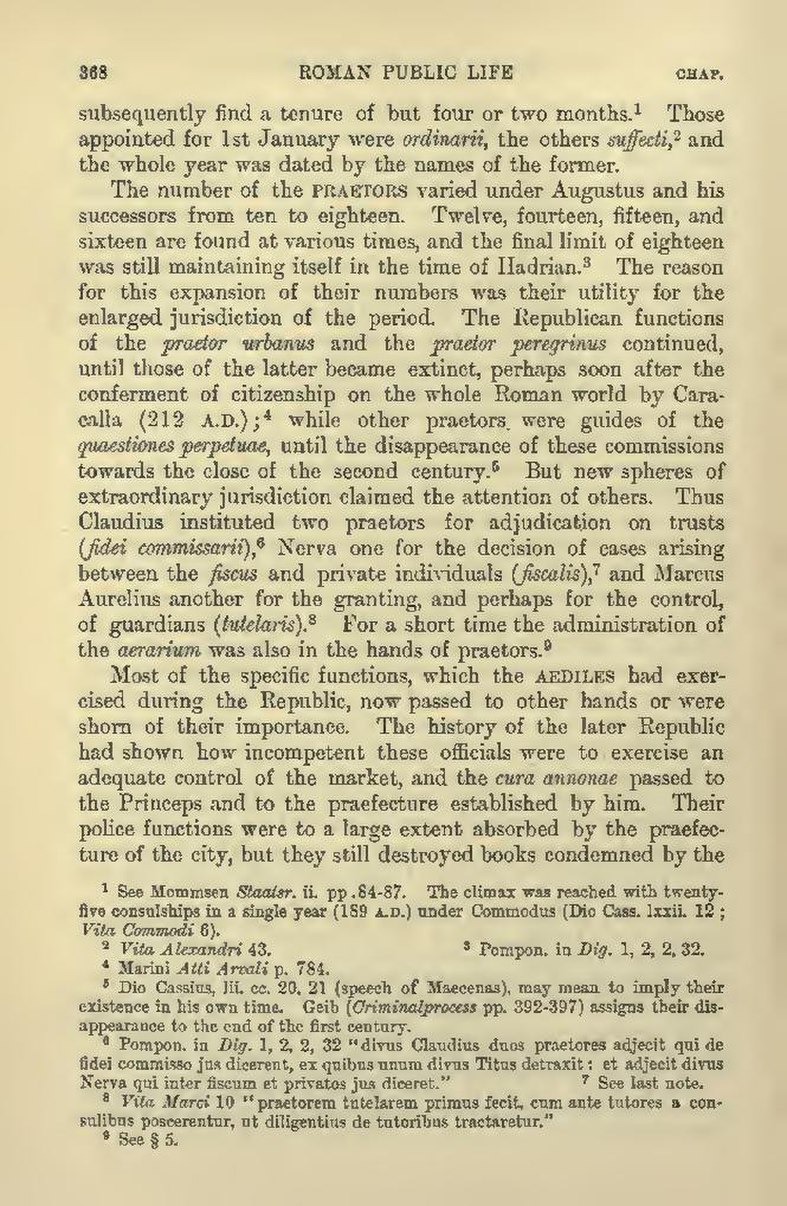subsequently find a tenure of but four or two months.[1] Those appointed for 1st January were ordinarii, the others suffecti,[2] and the whole year was dated by the names of the former.
The number of the PRAETORS varied under Augustus and his successors from ten to eighteen. Twelve, fourteen, fifteen, and sixteen are found at various times, and the final limit of eighteen was still maintaining itself in the time of Hadrian.[3] The reason for this expansion of their numbers was their utility for the enlarged jurisdiction of the period. The Republican functions of the praetor urbanus and the praetor peregrinus continued, until those of the latter became extinct, perhaps soon after the conferment of citizenship on the whole Roman world by Caracalla (212 A.D.);[4] while other praetors, were guides of the quaestiones perpetuae, until the disappearance of these commissions towards the close of the second century.[5] But new spheres of extraordinary jurisdiction claimed the attention of others. Thus Claudius instituted two praetors for adjudication on trusts (fidei commissarii),[6] Nerva one for the decision of cases arising between the fiscus and private individuals (fiscalis),[7] and Marcus Aurelius another for the granting, and perhaps for the control, of guardians (tutelaris).[8] For a short time the administration of the aerarium was also in the hands of praetors.[9]
Most of the specific functions, which the AEDILES had exercised during the Republic, now passed to other hands or were shorn of their importance. The history of the later Republic had shown how incompetent these officials were to exercise an adequate control of the market, and the cura annonae passed to the Princeps and to the praefecture established by him. Their police functions were to a large extent absorbed by the praefecture of the city, but they still destroyed books condemned by the
- ↑ See Mommsen Staatsr. ii pp.84-87. The climax was reached with twenty-five consulships in a single year (189 A.D.) under Commodus (Dio Cass. lxxii. 12; Vita Commodi 6).
- ↑ Vita Alexandri 43.
- ↑ Pompon. in Dig. 1, 2, 2, 32.
- ↑ Marini Atti Arvali p. 784.
- ↑ Dio Cassius, lii. cc. 20, 21 (speech of Maecenas), may mean to imply their existence in his own time. Geib (Criminalprocess pp. 392-397) assigns their disappearance to the end of the first century.
- ↑ Pompon. in Dig. 1, 2, 2, 32 "divus Claudius duos praetores adjecit qui de fidei commisso jus dicerent, ex quibus unum divus Titus detraxit: et adjecit divus Nerva qui inter fiscum et privatos jus diceret."
- ↑ See last note.
- ↑ Vita Marci 10 "praetorem tutelarem primus fecit, cum ante tutores a consulibus poscerentur, ut diligentius de tutoribus tractaretur."
- ↑ See § 5.
